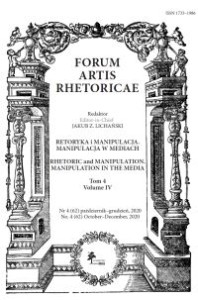Lector Benevole,
Szanowni Państwo!
Na początku roku 2020 Redakcja zdecydowała, iż cały rocznik, podzielony na
cztery tomy, zostanie poświęcony tematowi RETORYKA I MANIPULACJA.
Niniejszy, czwarty tom, to zbiór studiów poświęconych narzędziom manipulacji
w mediach. Analiza przekazów medialnych: prasowych, telewizyjnych i internetowych
pokazała rozmaite techniki i strategie pozwalające nadawcom osiągać
swoje cele nie tylko za pomocą słów, ale też odpowiednio skonstruowanych obrazów
i dźwięków.
Tom rozpoczyna tekst Barbary Sobczak, Media i manipulacja (Media
and manipulation), w którym podjęty został problem defi niowania manipulacji
w badaniach nad mediami w kontekście nieuprawomocnionego przekonania o jej
nieuniknioności w komunikacji medialnej. Autorka zwraca uwagę na konieczność
ograniczenia zakresu znaczeniowego terminu manipulacja i wskazanie jej
najważniejszych cech kategorialnych. Za takie uznaje: intencjonalność (związaną
z działaniem strategicznym), brak świadomości odbiorcy i korzyść nadawcy.
Aktualny stan badań na temat perswazji i manipulacji opisuje Rafał Siekiera
w tekście Standardy semantyczne jako narzędzie wpływu na odbiorców telewizyjnych
(Semantic standards as a tool of infl uencing tv spectators). Zauważa w nich
jednak istotną lukę — brak opracowań na temat wykorzystania standardów
semantycznych do zmiany sposobu postrzegania i oceniania zjawisk i ludzi.
Wykorzystuje więc metodologię gramatyki komunikacyjnej, by opisać mechanizm
i sposoby manipulowania standardami semantycznymi w polskich serwisach
informacyjnych. Dowodzi, że odwoływanie się do tego, co jest dobrze znane,
i modyfi kowanie tego, może wzbudzać w odbiorach dysonans poznawczy, ale też
osłabiać ich czujność i powodować zmianę znaczenia przypisywanego osobom,
zdarzeniom czy zjawiskom.
Newsem telewizyjnym zajmuje się też Agnieszka Barczyk-Sitkowska (Wybrane
sposoby manipulowania zawartością przekazów audiowizualnych za pomocą
montażu na przykładzie telewizyjnego newsa. Studium przypadku / Selected
methods of manipulation in the content of audiovisual messages using fi lm editing
on the example of TV news. Case study), która podejmuje problem manipulacji
przekazem audiowizualnym za pomocą montażu. Na przykładzie skonstruowanego
przez siebie newsa analizuje rolę montażu jako narzędzia selekcji informacji,
budowania dramaturgii i relacji skojarzeniowych, a także manipulowania relacją
między warstwą dźwiękową i obrazową w poszczególnych ujęciach.
Po narzędzia gramatyki komunikacyjnej sięga również Anita Filipczak-
-Białkowska, która opisuje zjawisko clickbaitu w internecie. W tekście Zaciekawić
odbiorcę. Zarządzanie poziomem informatywności internetowych zapowiedzi
dziennikarskich (Awaken receiver`s interest. Managing the level of informativeness
of the internet previews) analizuje ona wybrane strategie generowania luki
informacyjnej w zapowiedziach dziennikarskich publikowanych w portalu wp.pl.
Za działanie o charakterze manipulacyjnym uznaje dostarczanie przez nadawcę
niedostatecznej liczby danych (jako składników informacji) w zapowiedzi, czego
celem jest skupienie uwagi odbiorcy na przekazie reklamowym lub treściach
niekoniecznie dla niego interesujących.
Monika Worsowicz z kolei na przykładzie pisma dla kobiet „Claudia” analizuje
proces komodyfi kacji, a więc „utowarowienia” prasy kobiecej. W artykule
Cui bono? O manipulowaniu potrzebami czytelniczek na przykładzie ewolucji
tzw. metamorfoz „Claudii” (Cui bono? About manipulating the needs of readers on
the example of the evolution of the so-called metamorphoses of „Claudia”) dowodzi,
że pisma poradnikowe dla kobiet utraciły swój dziennikarski charakter
i stały się narzędziem reklamowym wydawców, na co wskazuje między innymi
selekcja tematów i bohaterek publikacji, dobieranych ze względu na możliwość
kojarzenia opisywanych problemów z określonymi produktami. Za manipulację
uznaje celowe łączenie funkcji informacyjnych z reklamowymi w obrębie jednego
tekstu, co utrudnia odbiorcom właściwe dekodowanie przekazów i dostrzeganie
granicy między treściami pochodzącymi od redakcji i od podmiotów komercyjnych.
Autorka pokazuje ten mechanizm na przykładzie jednego z gatunków prasy
poradnikowej — tzw. metamorfozy.
Zgromadzone w niniejszym tomie teksty otwierają pole do kolejnych badań
i dyskusji i dowodzą, że manipulacja w mediach to wciąż interesujący i niewystraczająco
opisany problem badawczy.
Kind Reader!
At the beginning of 2020, the editors decided that the entire yearly, divided
into four volumes, would be devoted to the subject of RHETORICS AND
MANIPULATION.
Th e present, fourth volume is a collection of studies on media manipulation
tools. Th e analysis of media messages: press, TV and Internet allowed to show
various techniques and strategies that allow broadcasters to achieve their goals
not only with words, but also with properly constructed images and sounds.
Th e volume begins with the text by Barbara Sobczak, Media and manipulation,
in which the problem of defi ning manipulation in media research in the context
of the unjustifi ed belief that manipulation in media communication is inevitable.
Th e author points out the need to limit the meaning of manipulation and to
indicate its most important categorical features. It recognizes as such:
intentionality (related to strategic activity), lack of awareness of the recipient
and the benefi t of the sender.
Th e current state of research on persuasion and manipulation, especially
in the fi eld of psychology and linguistics, is described by Rafał Siekiera in the text
Semantic standards as a tool of infl uencing tv spectators. However, he notices
a signifi cant gap in them — the lack of studies on the use of semantic standards
to change the way of perceiving and assessing phenomena and people. Th erefore,
he uses the methodology of communicative grammar to describe the mechanism
and ways of manipulating semantic standards in Polish news services. It proves
that referring to what is well known and modifying it may arouse cognitive
dissonance in the recipients, but also weaken their vigilance and cause a change
in the meaning assigned to people, events or phenomena.
Agnieszka Barczyk-Sitkowska also deals with television news (Selected
methods of manipulation in the content of audiovisual messages using fi lm
editing on the example of TV news. Case study), which addresses the problem
of manipulating the audiovisual message by means of editing. Using the example
of news he has constructed, he analyzes the role of editing as a tool for selecting
information, building dramaturgy and associative relations, as well as manipulating
the relationship between the sound and image layers in individual shots.
Communication grammar tools also appear in Anita Filipczak-Białkowska’s text,
which describes the clickbait phenomenon on the Internet. In the text I am interested
in the recipient. Managing the Level of Informativeness of the Internet Previews —
she analyzes selected strategies of generating an information gap in journalistic
announcements published on the wp.pl portal. It considers the sender to provide an
insuffi cient amount of data (as information components) in the announcement as
a manipulative action, the purpose of which is to focus the recipient’s attention on
the advertising message or content not necessarily interesting to him.
Monika Worsowicz, on the other hand, uses the example of the magazine
for women „Claudia” to analyze the commodifi cation process of women’s press.
In the article (Cui bono? About manipulating the needs of readers on the example
of the evolution of the so-called metamorphosis of „Claudia” which is indicated,
among others, by the selection of topics and heroines of the publications, selected
due to the possibility of associating the described problems with specifi c products.
He considers manipulation to intentionally combine information and advertising
functions within one text, which makes it diffi cult for recipients to properly
decode messages and see the boundary between the content from the editorial
offi ce and commercial entities. Th e author shows this mechanism on the example
of one of the types of the guide press — the so-called metamorphosis.
Th e texts collected in this volume open the fi eld for further research
and discussion and prove that manipulation in the media is still an interesting
and insuffi ciently described research problem.
Poznań, 2020-10-07
Barbara Sobczak
ORCID 0000-0002-1408-8256


 62 (2020)
62 (2020)
